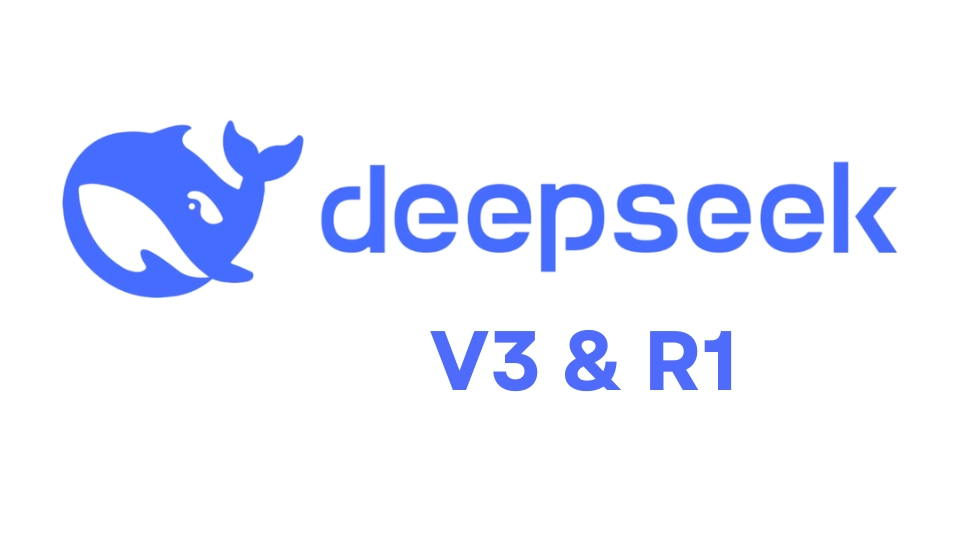DeepSeek has rapidly gained recognition in the artificial intelligence landscape, particularly with the introduction of its two flagship models: DeepSeek-V3 and DeepSeek-R1.
Both models are designed to address different aspects of AI functionality, catering to diverse user needs in natural language processing and reasoning tasks.
Let’s explore the main differences between these two models, including their architectures, training methodologies, performance metrics, applications, and cost efficiency.
- Overview of DeepSeek Models
- Key Differences Between DeepSeek-V3 and DeepSeek-R1
- FAQs
- 1. What are the main differences between DeepSeek-V3 and DeepSeek-R1?
- 2. Which model is better for reasoning tasks?
- 3. Can both models be used in commercial applications?
- 4. How do the training methodologies differ between the two models?
- 5. Which model would be more cost-efficient for small-scale applications?
- Conclusion

Overview of DeepSeek Models
DeepSeek-V3
DeepSeek-V3 is a state-of-the-art large language model (LLM) that employs a Mixture-of-Experts (MoE) architecture. This innovative design allows only a subset of parameters to be activated for each token processed, significantly enhancing computational efficiency while maintaining high-performance levels.
With an impressive total of 671 billion parameters, DeepSeek-V3 activates approximately 37 billion parameters per token, making it versatile for a wide range of natural language processing tasks. The model is primarily designed for general-purpose applications.
It excels in tasks that require understanding and generating human-like text, making it suitable for chatbots, content creation, translation services, and more. The architecture's scalability allows it to handle various languages and dialects effectively.
DeepSeek-R1
In contrast, DeepSeek-R1 is specifically engineered for advanced reasoning capabilities. It utilizes a different approach to training and architecture that emphasizes logical inference and problem-solving.
This model employs a two-stage training process that includes both supervised fine-tuning and reinforcement learning techniques.DeepSeek-R1 is particularly adept at handling complex logical tasks, mathematical reasoning, and scenarios requiring deep cognitive capabilities. Its architecture is optimized for long-chain thought processes, making it ideal for applications in education, research, and domains where precise reasoning is crucial.
Key Differences Between DeepSeek-V3 and DeepSeek-R1
Purpose and Focus
The primary distinction between DeepSeek-V3 and DeepSeek-R1 lies in their intended purposes:
DeepSeek-V3: This model focuses on broad natural language processing applications. It is designed to perform well across various tasks such as text generation, summarization, translation, and conversational AI. Its versatility makes it suitable for businesses looking to implement AI solutions across multiple platforms.
DeepSeek-R1: In contrast, this model specializes in advanced reasoning capabilities. It is tailored for tasks that require logical deduction, mathematical problem-solving, and complex decision-making. Organizations that need AI systems capable of deep analysis will find R1 particularly beneficial.
Architecture
The architectural differences between the two models are significant:
DeepSeek-V3: The MoE architecture allows the model to activate only a portion of its extensive parameter set during processing. This selective activation leads to lower computational costs while maintaining high performance across diverse NLP tasks. The architecture supports efficient scaling without sacrificing quality.
DeepSeek-R1: This model employs a dense reasoning architecture optimized for reinforcement learning tasks. It is structured to support advanced reasoning techniques such as chain-of-thought (CoT) processing. The design prioritizes logical thinking over general text generation capabilities.

DeepSeek R1 vs DeepSeek V3
Training Methodology
The training methodologies also differ substantially between the two models:
DeepSeek-V3: Trained on an extensive dataset comprising 14.8 trillion tokens, DeepSeek-V3 utilizes a combination of supervised fine-tuning alongside reinforcement learning techniques. This comprehensive training approach allows the model to adapt effectively to various contexts and user inputs.
DeepSeek-R1: In contrast, R1 employs a two-stage training strategy that combines cold-start reinforcement learning with supervised fine-tuning aimed at enhancing its reasoning capabilities. The focus during training is on developing logical thinking skills and problem-solving abilities.
Performance Metrics
Performance benchmarks provide insight into how each model performs in real-world scenarios:
DeepSeek-V3:Achieveds a pass rate of 90.2% on MATH-500, demonstrating solid performance in mathematical reasoning tasks.
Scores 39.2% on AIME 2024, indicating its proficiency in logical challenges but not as high as R1.
DeepSeek-R1:
Excels with a pass rate of 97.3% on MATH-500, showcasing its superiority in mathematical problem-solving.
Achieves an impressive 79.8% on AIME 2024, highlighting its effectiveness in reasoning-intensive tasks.
These metrics illustrate that while both models are powerful, they excel in different areas—V3 in general NLP tasks and R1 in logic-based challenges.
Applications
Understanding the applications of each model can help organizations determine which one fits their needs:
DeepSeek-V3: This model is best suited for applications requiring multilingual support and general AI tools like chatbots or virtual assistants. Its ability to generate coherent text makes it ideal for content creation platforms, customer service automation, and educational tools that need interactive features.
DeepSeek-R1: This model shines in environments where deep reasoning is essential. It can be utilized in academic research settings where complex logical deductions are necessary or by financial institutions needing accurate calculations based on intricate data sets. Additionally, educational tools focused on STEM subjects can leverage R1's advanced capabilities.
Cost Efficiency
When considering cost efficiency between the two models:
DeepSeek-V3: Although it has a larger parameter count than R1, its MoE architecture allows for cost-effective training due to reduced GPU hours needed per task. For instance, it requires approximately 2.788 million H800 GPU hours for training but can handle multiple tasks simultaneously due to its scalable nature.
DeepSeek-R1: While R1 demands fewer GPU resources due to its focused training strategy—approximately 0.9 million H800 GPU hours—it is primarily optimized for specific reasoning tasks rather than broad applications. Organizations looking to implement targeted solutions may find R1 more cost-effective for specialized use cases.
User Experience
User experience plays a crucial role when choosing between these models:
DeepSeek-V3: Users benefit from an intuitive interface that allows easy integration into existing systems. The model's versatility means it can adapt to various user inputs without extensive customization.
DeepSeek-R1: While R1 may require more initial setup due to its specialized nature, users who need advanced reasoning capabilities will find its outputs highly valuable. The focus on logical deductions can enhance decision-making processes significantly.
Scalability
Scalability is another important factor:
DeepSeek-V3: Its architecture supports rapid scaling across multiple applications without significant performance degradation. Businesses can deploy V3 across various platforms with ease.
DeepSeek-R1: While scalable within its domain of reasoning tasks, R1 may not be as versatile as V3 when applied outside logical deduction scenarios.
Community Support and Development
Both models benefit from community engagement:
DeepSeek-V3: Being open-source encourages contributions from developers worldwide who enhance its features and capabilities regularly.
DeepSeek-R1: Although more specialized, R1 also has an active community focused on improving its reasoning algorithms and expanding its application range.
Feature
DeepSeek-V3
DeepSeek-R1
Purpose
General-purpose natural language processing
Advanced reasoning and logical deduction
Architecture
Mixture-of-Experts (MoE)
Dense reasoning model optimized for RL
Parameters
671 billion total parameters; ~37 billion activated per token
Focused on reasoning tasks; fewer parameters activated
Training Methodology
Trained on 14.8 trillion tokens; uses supervised fine-tuning and RL
Two-stage training: cold-start RL and supervised fine-tuning
Performance Metrics
90.2% pass rate on MATH-500; 39.2% on AIME 2024
97.3% pass rate on MATH-500; 79.8% on AIME 2024
Applications
Chatbots, content creation, translation services
Academic research, financial calculations, STEM education tools
Cost Efficiency
Requires ~2.788 million H800 GPU hours
Requires ~0.9 million H800 GPU hours
User Experience
Intuitive interface for diverse applications
More specialized setup for advanced reasoning tasks
Scalability
Highly scalable across multiple applications
Scalable within reasoning tasks but less versatile overall
Community Support
Active open-source community
Active community focused on reasoning improvements
FAQs
1. What are the main differences between DeepSeek-V3 and DeepSeek-R1?
Both models differ primarily in their intended purposes; V3 focuses on broad natural language processing applications while R1 specializes in advanced reasoning capabilities.
2. Which model is better for reasoning tasks?
DeepSeek-R1 outperforms V3 in reasoning-specific benchmarks due to its targeted training approach designed for logical deduction.
3. Can both models be used in commercial applications?
Yes, both models are open-source and can be deployed in various commercial settings depending on application needs.
4. How do the training methodologies differ between the two models?
V3 uses a combination of supervised fine-tuning and reinforcement learning over a large dataset while R1 employs a two-stage process focused on enhancing reasoning capabilities through cold-start RL followed by supervised fine-tuning.
5. Which model would be more cost-efficient for small-scale applications?
DeepSeek-R1 may be more cost-efficient for small-scale applications that require focused reasoning capabilities due to its lower GPU resource requirements compared to V3's larger scale.
Conclusion
In summary, both DeepSeek-V3 and DeepSeek-R1 represent significant advancements in AI technology but serve different needs within the industry:
DeepSeek-V3 is the go-to option for organizations seeking scalable solutions for diverse natural language processing tasks due to its efficiency and broad applicability.
On the other hand, DeepSeek-R1 excels in environments where deep reasoning and logical deduction are paramount, making it invaluable for specialized applications in research and problem-solving.
By understanding the strengths and capabilities of each model, organizations can make informed decisions about which AI solution aligns best with their specific requirements.




.png)


Comments